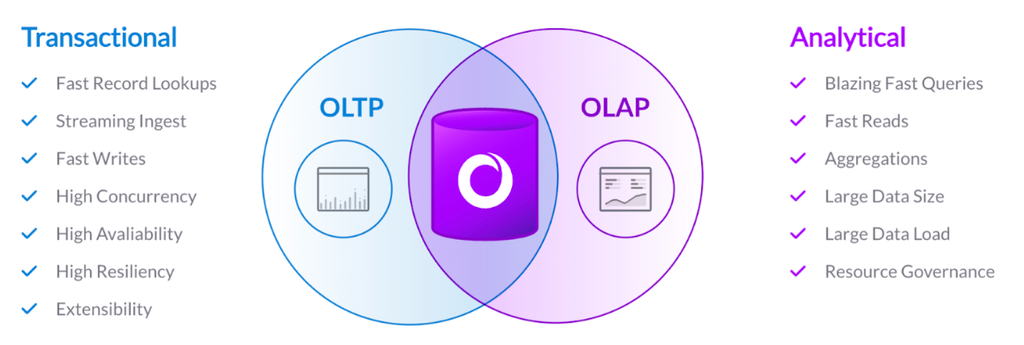
There’s recently been a massive wave of activity and announcements in the database space. From new features to future product roadmaps, database providers are placing their stakes in the ground to be among the leaders in a real-time application market that continues to heat up.
In just the last few weeks, we’ve seen:
- Google announce their OLTP database, AlloyDB. A fully managed, PostgreSQL-compatible database, AlloyDB aims to simplify enterprise-grade workloads with features like elastic storage and compute, intelligent caching and AI/ML capabilities.
- MongoDB reveal Column Store Indexes. Expected to be available later this year, this feature will allow users to create and maintain a purpose-built index that speeds up analytical queries without requiring document structure changes.
- Snowflake launch Unistore, their take on combining transactional and analytical workloads together in a single platform.
Well, that last one sounds awfully familiar…
With a single table type released in 2019 called Universal Storage, and hundreds of customers in production using it, SingleStoreDB is the #1 database for unified operational and analytical processing. We’ve long known that database unification can be done — and by carefully understanding the requirements of both transactional and analytical databases, have blazed a trail into the data-intensive era.

It’s clear that what’s happening in the database industry is a shift toward unified, real-time analytics and applications. And to better understand what this all means, we recently hosted a Twitter Space, inviting database industry thought leaders to share their perspective. Keep reading to get their take.
One Database to Rule Them All
Years ago, Dr. Michael Stonebraker claimed that you can’t have one database that fits all purposes and requirements. But as we’ve seen with SingleStoreDB, that notion is long gone.
“As applications have evolved, they need to do more than just writing data,” says Yatharth Gupta, VP of Product Management at SingleStore. “They need to reason on data the moment it’s created — when you go to hotels.com you see not only hotels, but recommendations. You see how many people are looking at the hotel, and how many are booking. These kinds of scenarios have become commonplace, this is what’s needed in the digital economy. “
“We at SingleStore have long held the belief that you shouldn’t need to move data from one database to another database to actually take action on the data. You should be able to read, write and reason on data at the same time, in the same place.”
Unistore isn’t yet generally available to the public — and truth be told, we’re not a fan of waiting. We’ve got real time, right now.
Try SingleStoreDB — the #1 database for unified operational and analytical processing — free today.
From Big Data to Data Intensity
Since ushering in the first era more than 20 years ago, cloud databases have gone through constant evolution. From general-purpose SQL databases to special-purpose NoSQL systems, several trends — including faster internet, mass adoption of modern applications, and the need for unified transactional and analytical processing — have driven database market disruption to lead us to the present, data-intensive era.
“It’s not just about doing something with the data, it’s what you do with the data,” says Oliver Schabenberger, former CTO of SaaS and current CIO at SingleStore. “How do you get maximum value from it — how do you deal with increasing data size, increasing query complexity, demands for lower query latency and higher concurrency? Those are aspects of modern applications that the data store needs to be capable of supporting. And, you only get this with a single store — a unified storage engine.”
As Schabenberger points out, many organizations call out the desire to be data driven — but calls out an important question: Do you simply want to get more out of your data, or do you want to get highly automated decision support from your data? That means being more real time, responsive and reactive — and ultimately, landing in the data-intensive era.
How data intensive are your applications? Take this three-minute assessment to find out.
The Proof Is in the Performance — and the Price
We’re thrilled to share that GigaOm recently conducted a Performance and Total Cost of Ownership (TCO) analysis, revealing that SingleStoreDB delivers better performance and a 50% lower TCO against the combination of MySQL and Snowflake, and a 60% lower TCO against the combination of PostgreSQL and Redshift.
The study compares SingleStoreDB as a distributed, general purpose SQL database to Amazon Redshift and Snowflake with two analytical workloads, and with a transactional workload. The goal? To determine whether SingleStoreDB — as a multiple workload platform — performs at a level comparable to some of the market’s most popular cloud databases.
We’d hate to give away the ending. Get your free copy of the GigaOm report today.
Don’t Miss the Latest Industry News From SingleStoreDB
Follow us on Twitter @SingleStoreDB to keep pace with the latest database trends, market shifts and product features.





